Limited Water Affects People around the World
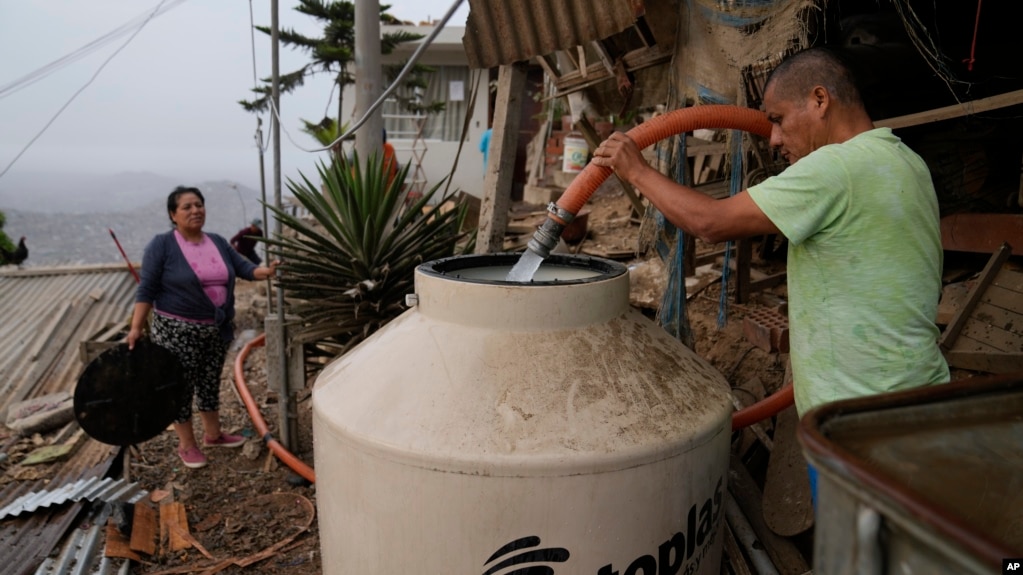
People around the world are worried that water for drinking, cooking and cleaning is getting harder to find. Many believe changes in their climate are affecting their ability to get water.
The problem exists in places such as Corning, California; Lima, Peru; Jakarta, Indonesia; Ras El Ma, Morocco; Makueni County, Kenya, and Bawal, India.
The United Nations says 2.2 billion people worldwide do not have safely managed drinking water.
Lima, Peru
In Lima, Justina Flores lives with no running water. She is a 50-year-old grandmother who gets water from the government. With the supply, she washes her family’s clothing by hand and then uses what is left to bathe her dog.
The government gives water to 1.5 million of the country’s poorest people. Big water trucks make their way up hills to get to places where people need it. Flores tries to limit her water use. She owns a washing machine, but it uses too much water. By washing clothes by hand, she saves about 45 liters. The family gets 3,000 liters per week. Official information says, in wealthier areas with running water, families use an average of almost 12,000 liters per week.
Flores has worked in some of those homes. She said, there, people can take a bath every day. She said in her area of Lima, people can only wash themselves two times per week.
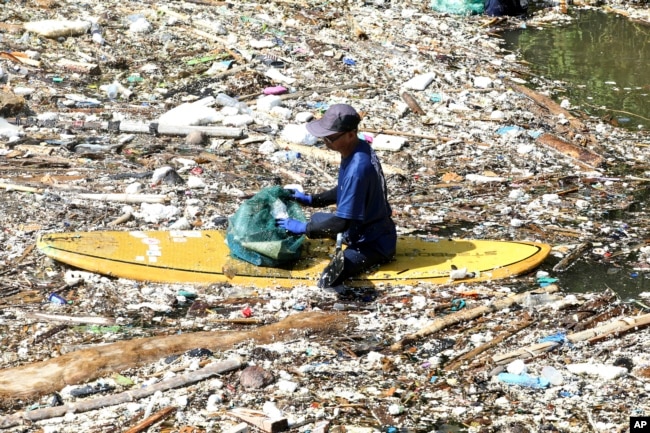
An environmental activist sits on a surf board as he picks up trash from a garbage-strewn river during a river clean up in Pecatu, Bali, Indonesia on Friday, March 22, 2024. (AP Photo/Firdia Lisnawati)
Jakarta, Indonesia
In Indonesia’s capital, Jakarta, people say it is difficult to get clean water.
Devi Putri Eka Sari is 37. She has three children. Since she was a girl, she has had to purchase water from sellers who work in her low-income neighborhood. While the government installed water pipes and pumps, the water does not always come.
Sari said, if the water did flow, she is not sure she would drink it. “It’s not healthy,” she said. “It’s filled with bacteria that will make you sick.” She said it also smells like chemicals.
The World Health Organization says she is right. Seven of 10 households in Indonesia use drinking water that contains the dangerous bacteria known as E. coli.

Devi Putri Eka Sari, a stay-at-home mother, stands outside her house with her son Satria Fareji, near bottles she uses to collect water, in Jakarta, Indonesia. (AP Photo/Dita Alangkara)
As a result, she and many other Indonesians have been buying water all their lives. They either use large, refillable containers or single-use bottles. This creates a lot of waste.
“It’s the option we have,” she said.
Ras El Ma, Morocco
In the North African country of Morocco, a river flows next to the farm where Mimoun Nadori’s family has grown fruits and vegetables for a long time.
But when he tastes the water from the river today, he makes a bad face. The water is salty. He said it was not that way in the past. Back then, as he said: “Everything was green. We drank from the river and washed with the river. We made a life with it.”
His land is along the Moulouya River, which does not flow like it did in the past. Dams were built and water is pumped upstream. That means Nadori’s land gets less water. The water hardly moves, which permits seawater to come in.
Nadori now has to bring water in for the chickens he raises. He once raised cows, but he discovered the cows were drinking from the tainted water. The cows died.
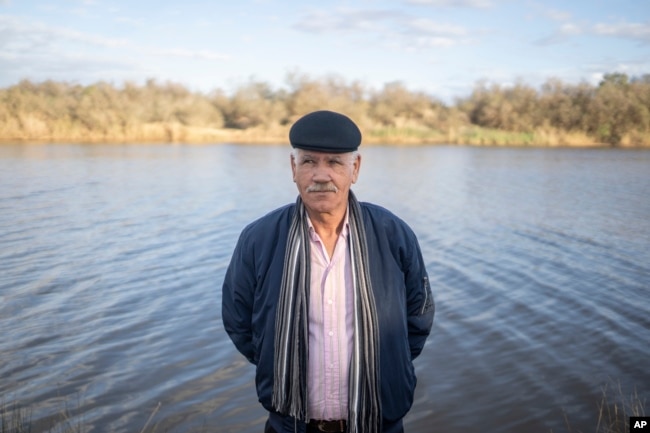
Mimoun Nadori poses for a portrait in front of the Moulouya River, in Nador, Morocco. Less rainfall and more damming and pumping upstream has left less water flowing through the river and threatened the livelihoods of farmers like Nadori. (AP Photo/Mosa'ab Elshamy)
He admitted there is more than one reason for the lack of water.
“We won’t lie and say the reason is only humans or drought, it’s both,” he said. “We don’t know how to use water and we waste a lot of water.”
Corning, California, United States
Fred and Robin Imfeld once had no problem filling their swimming pool and watering the plants at their home in rural California. But two years ago, their well in the town of Corning went dry. The pool is empty now, and the plants are brown.
Across California, wells have dried up because people use too much water and there is not enough rain to replace what is used. The supply of groundwater is low. The Imfelds want to drill a new, deeper well. But it would cost a lot: $25,000.
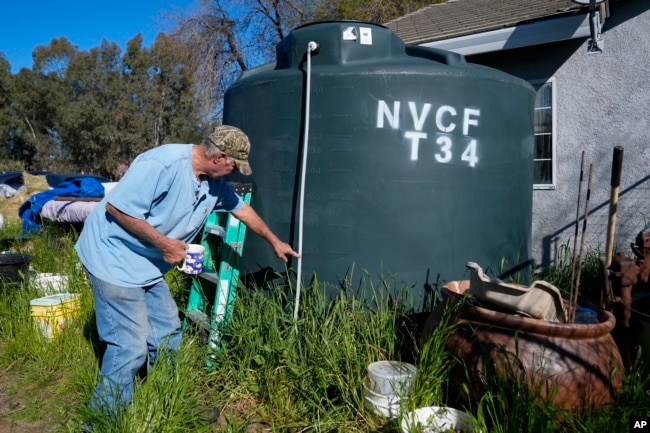
Fred Imfeld points to the level on his water tank Sunday, March 17, 2024, in Corning, Calif. They also get potable water delivered as the couple tries to save to drill a new well. (AP Photo/Godofredo A. Vásquez)
Until they can drill the new well, they depend on water from the state. Two times each month, they receive a water tank that contains almost 10,000 liters. They use the water to wash themselves, wash dishes and clean their clothes. They get a different shipment of 113 liters of water every two weeks that they use for drinking and cooking. When they need more water, Imfeld takes all the containers he has to a friend’s home a few kilometers away and fills them.
He said the worries about water add to the family’s personal concerns. They are worried all the time about their own lives and the water. “We’re just being emotionally drained,” he said.
Makueni County, Kenya
Joyce Mule used to walk two hours each day to find water in Makueni County, Kenya. There are few water pipes in her southeastern village.
One way to get water is by digging holes in a local riverbed and retrieving the collected water.
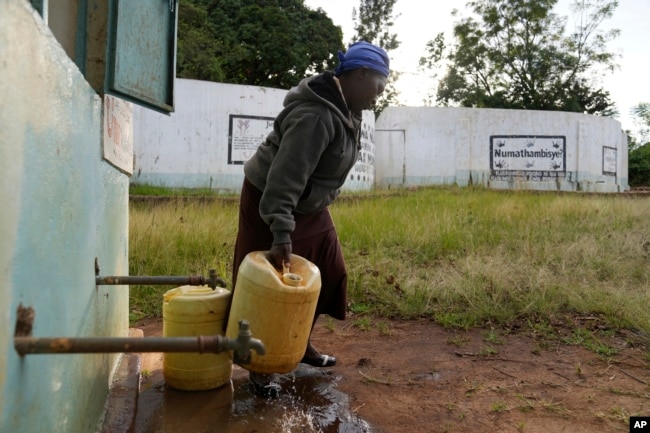
Joyce Mule fills jugs with water from a rock catchment system in Makueni County, Kenya on Thursday, Feb. 29, 2024. Villagers put big stones to filter the rainwater and a pipe to take the water down to storage tanks. (AP Photo/Brian Inganga)
But in 2012, she and the others in the village changed to a different method. They now catch water that runs off rocks 30 or more meters above the ground.
The rock catchment method directs the water through a containing wall and smaller rocks that help to clean it. Eventually the water flows into a pipe and into a large tank that is much closer to the village.
Her plants and trees are now healthy. There is more fruit and cows are producing more milk. Her life is better now.
“We used to think the rocks were worthless,” she said. “But now we see the benefits.”
Bawal, India
Ramkrishan Malawat is 52. He remembers the days when people in his village near New Dehli did not have to dig deep wells to get water. They only needed to walk 10 kilometers to find a fast-flowing river. Water was no concern.
Now, the river is dry, and the water is more than 70 meters below the ground. “We are forced to dig deeper with every passing year,” he said. But he must keep digging in order to get water for his farm – he grows mustard, corn and other grains.
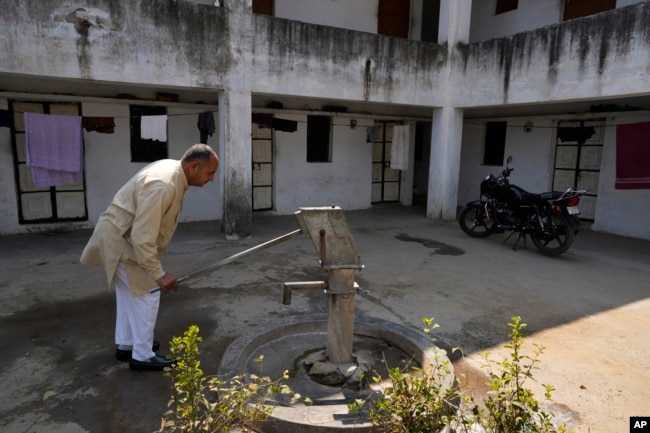
Farmer Ramkrishan Malawat takes out water from a hand pump which is on its last leg in Bawal, in the Indian state of Haryana. “There is so much construction around here and when it rains now, the water just flows away," he said. (AP Photo/Manish Swarup)
When he does get to the water, it is not as clean. The water contains chemicals from the ground – including fluoride.
Drilling for water is common in India. The United Nations says India drills and pumps more groundwater than the United States and China combined.
There is more need for water as India grows. The Indian population is the world’s largest, and it continues to grow. The people need homes and jobs. Every time a new structure is built, it causes runoff, and less water can seep into the ground.
“Water just flows away,” Malawat said. He noted that the auto industry is now bigger than farming in the area.
“I worry sometimes that in 10 to 15 years, there will be no good water available for farming in my town,” he said.
Words in This Story
install –v. to put a piece of equipment or a part in place
option –n. a choice that can be made
upstream –adj. the area nearer to the source of a river or stream
tainted –adj. containing something that should not be there
drought –n. an extended period of lower-than-normal rainfall for the climate of a place
drain –v. to have something flow away or disappear from where it normally is
seep –v. to slowly flow down into the group
https://learningenglish.voanews.com/a/limited-water-affects-people-around-the-world/7549353.html